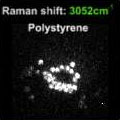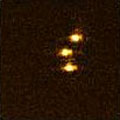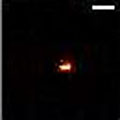Single shot wide-field CARS at video-rate
The high efficiency of CARS can enable chemically specific imaging in real-time. We demonstrated the recording of CARS-snapshots at an acquisition rate of 30Hz, where the signal of each frame was generated by a single laser pulse pair of around 3 ns length.
The sample used was a mixture of polystyrene and PMMA beads, which show Raman peaks around 3052 and 2953 wavenumbers, respectively (see Fig. 1).
For the movie shown in Fig. 2, three recorded frames were combined to a single one of higher signal to noise ratio, which leads to a reduced frame rate to 10 Hz. The video shows realtime switching of the pump beam wavelength to visualize chemically different bead populations.
 |

Movie (7.17MB) |
The movies shown in Fig.3 demonstrate real time imaging of polystyrene beads in water at the resonances at 3052cm-1 and 1600cm-1. Each frame in the movies contains the CARS signal that was created by a single pump/Stokes pulse pair.

Movie (1.01MB) |

Movie (406KB) |



